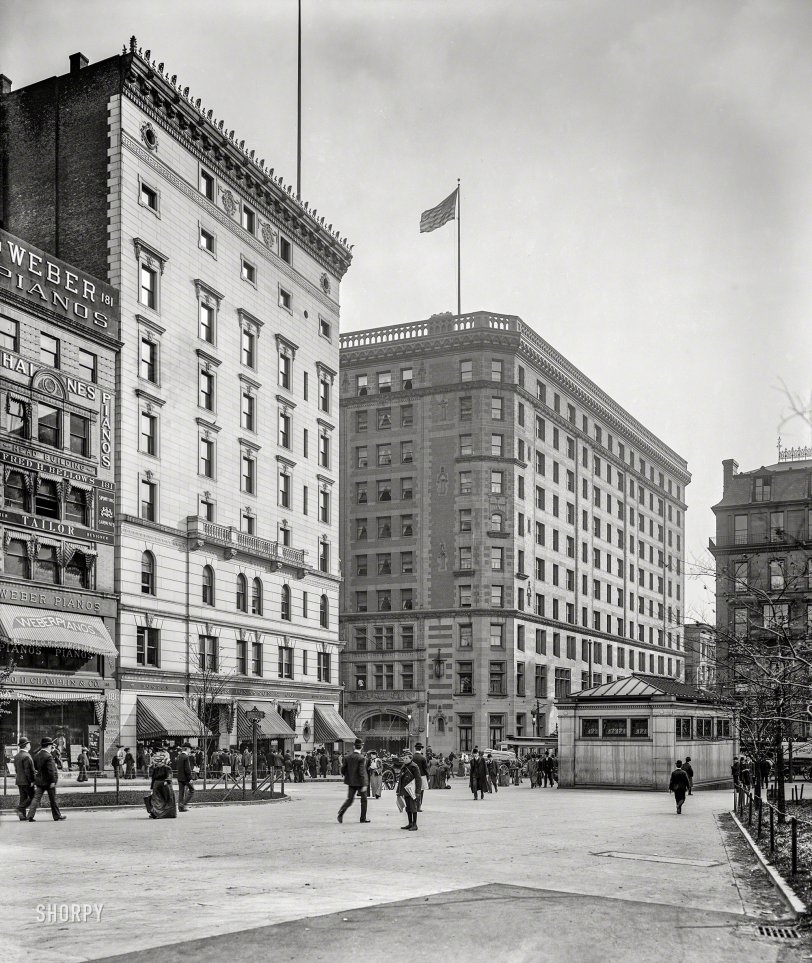


Framed or unframed, desk size to sofa size, printed by us in Arizona and Alabama since 2007. Explore now.
Shorpy is funded by you. Patreon contributors get an ad-free experience.
Learn more.

- Baldwin 62303
- Baldwin VO-1000
- Cold
- No expense spared
- Tough Guys
- Lost in Toyland
- And without gloves
- If I were a blindfolded time traveler
- Smoke Consumer Also Cooks
- Oh that stove!
- Possibly still there?
- What?!?
- $100 Reward
- Freeze Frame
- Texas Flyer wanted
- Just a Year Too Soon
- WWII -- Replacing men with women at the railroad crossing.
- Yes, Icing
- You kids drive me nuts!
- NOT An Easy Job
- I wonder
- Just add window boxes
- Icing Platform?
- Indiana Harbor Belt abides
- Freezing haze
- Corrections (for those who care)
- C&NW at Nelson
- Fallen Flags
- A dangerous job made worse
- Water Stop
Print Emporium
Lafayette Mall: 1904

Boston circa 1904. "Lafayette Mall -- Masonic Temple and Hotel Touraine." 8x10 inch dry plate glass negative, Detroit Photographic Company. View full size.
Two Heads Were Better Than One
Apkmax75 points out the head house of the subway station. Allow me to point out the Head Building over on the left edge, at 181 Tremont Street.
Alas, it was one head too many. The Head Building is now the Ansin Building, with a "1" subtracted from the address: it is now 180 Tremont Street instead of 181. (Don't know if the original building was replaced, or embiggened).
Boylston Station (1897)
Boylston and nearby Park Street were the first two stations in Boston's first-in-North America subway system. It's still there, at the southeastern corner of Boston Common, just down the street from this recent photo on Shorpy:
https://www.shorpy.com/node/23804
A lot is still the same
That shorter building is the head house for the Boylston Street subway station.
The more things change --
This is one of those wonderful Boston intersections (basically looking south on Tremont Street as it crosses Boylston Street) where nothing much has changed in 100+ years. Both the Masonic Temple and the Hotel Touraine buildings are still there, although the latter is no longer a hotel. The Masons still occupy the former. But each building is almost completely unchanged from the outside, except for things like a Starbucks occupying the corner of Boylston and Tremont in what used to be the Hotel. The squat concrete structure with the metal roof is the entrance to the Boylston Street station on the MBTA (the "T") Green Line, situated at the southeast corner of the Boston Common. It's still there, completely unchanged, as is the station below ground. (Some would say, unkindly, that the trolley cars on the Green Line haven't changed much since 1904 either.) The building at the far right of the picture, behind the station entrance, is gone, replaced by a larger building that is owned by Emerson College and is presently undergoing a sidewalk-to-rooftop renovation. The building at the far left, next to Masonic Hall, is also gone, replaced by a 14-story structure called the Ansin Building, which is now also part of Emerson College (alma mater of, among others, Jay Leno). But otherwise, that intersection, which is one of those crossroads where, if you stood there long enough, you'd wind up seeing almost everyone you ever knew in Boston, would feel very familiar even today to the newsboy standing in the middle of the picture, or any of the other pedestrians going about their business on what looks like a pleasant spring morning toward the end of President Teddy Roosevelt's first term in office.
Carpe diem
I know I'm not the only one who enlarges these photos and studies them from stem to stern, but I particularly enjoyed this one. I'm always struck by the pure ordinariness of the day. The two people washing windows. The middle-aged lady who appears to have dropped her handbag. The newsboy. The elegant ladies out shopping. The handsome young man hurrying to an appointment. All of them long dead. How they would have marveled at the thought of us poring over their blurry likenesses 115 years into the future. Trite but true: seize the day.
























On Shorpy:
Today’s Top 5